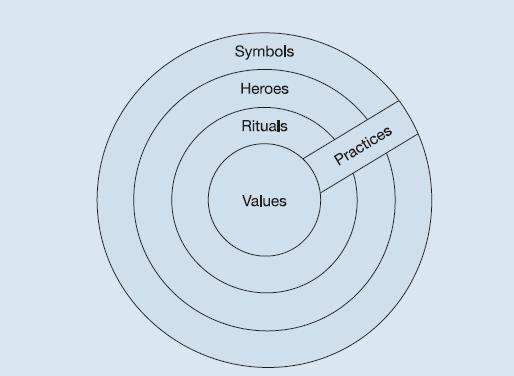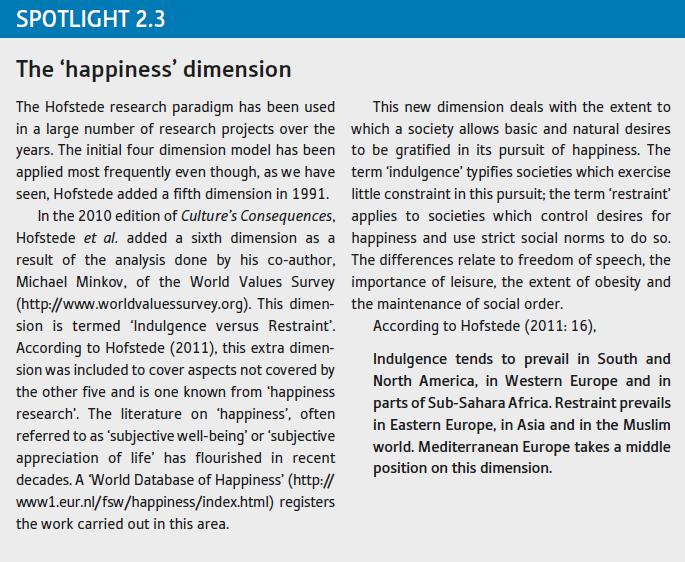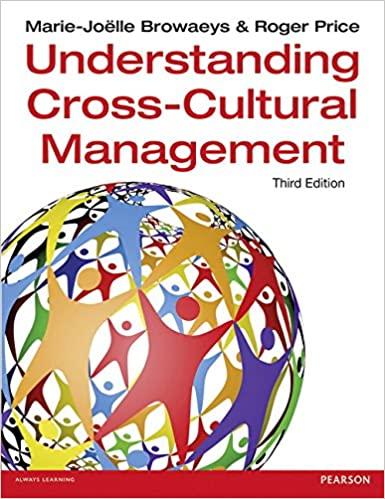On initial examination, the findings of the GLOBE project appear to be an ambitious and elaborate extension
Question:
On initial examination, the findings of the GLOBE project appear to be an ambitious and elaborate extension of Hofstede’s research, a ‘development of Hofstede’s doctrine’ and ‘a corrective of Hofstede’s model’.
Although it may have led to a better understanding of Hofstede’s work, the GLOBE findings challenged one of the basis tenants of the ‘doctrine’, namely Hofstede’s perception of the phenomenon of culture. The definition which Hofstede devised (‘the collective programming of the mind that distinguishes the members of one human group from another’ – see Concept 1.1 ) has values at its core. These are the invisible elements which are reflected in three layers: rituals, heroes and symbols – the visible manifestations of culture. In short, Hofstede (2001: 11) sees cultural values as driving practices reflected as such in his version of the ‘onion’ metaphor: ‘These are pictured as the layers of an onion around a core that consists of values’ (Figure 2.2).
Figure 2.2

The GLOBE approach followed a different line. As Javidan et al. (2006) explain, the project chose a different view of culture:
We followed Schein’s (1992) view of culture as a product of a collective’s attempts to address two sets of group issues: external adaptation and internal integration. Culture evolves as a collective adapts to ongoing challenges surviving in the face of external threats and opportunities and managing relations among its members.
They view culture as a phenomenon which is not only to do with values but also the practices used to deal with challenges which their society faces.
This holistic view led to questionnaires being devised which were not focused on what the individual respondents considered desirable, but instead on what they considered the society in which they lived should desire. As described in Concept 2.2 , the individuals were asked to describe their societies as they are and as they should be.
This approach put Hofstede’s assumption to the test that cultural values drive cultural practices.
The results of their research show that this assumption does not work. However counter-intuitive it may seem, the correlation between values and practices was found to be negative with regard to seven of the nine dimensions. Only Gender Egalitarianism shows a significant positive correlation. The idea, therefore, that people behave in a certain way because they hold particular values, that they have a particular view as to how things should be, does not hold water. As GLOBE’s research shows, values and practices are each linked to different phenomena. Cultural practices are related to a number of societal features such as life expectancy and national competitiveness. Cultural values, however, are related to what the society in question considers to be outstanding leadership. In short:
. . . leaders’ reported effectiveness is associated with the society’s cultural values and aspirations, but the society’s effectiveness is associated with its cultural practices.
In his review of GLOBE, Hofstede makes a number of criticisms, many of which emanate from what he terms the ‘unbridgeable differences’ (Hofstede 2006: 885) between the GLOBE approach and that of Hofstede himself. The questionnaire items used come in for criticism: they are very abstract in nature, difficult to understand and ‘may not have captured what the researchers supposed them to have captured’. The ‘As Is’ and ‘Should Be’ distinction is subjected to detailed criticism in the light of the distinction he makes between ‘values as the desired’ (what people actually and personally desire) and ‘values as the desirable’
(what they think they ought to desire). Hofstede (2006) believes that his values are measures of ‘the desired’
and therefore more predictive of practices. Unlike the questionnaire items in his surveys, none of the GLOBE items, he believes, measured ‘the desired’.
GLOBE’s response to this particular area of criticism is equally detailed and quite categorical:
. . . there is no empirical or theoretical justification for the assertion that GLOBE measures of values are too abstract or that the distinction between values as desirable versus values as desired is meaningful.
Hofstede’s review also includes a detailed re-analysis of GLOBE’s dimension scores. Since the nine dimensions used by GLOBE were significantly correlated among each other, he set about simplifying the scheme using a factor analysis. His eventual conclusion was that the GLOBE dimensions could be reduced to five – ‘and these show a family likeness with the Hofstede model’ (Hofstede, 2006: 895).
In reaction to this claim, GLOBE gave a further explanation of the research procedures and retorted that Hofstede ignored state-of-the-art methods used to ensure reliability and validity. Furthermore, they pleaded for an end to what they term the ‘Hofstedeian hegemony’ (Javidan et al. , 2006: 910). However ground-breaking his work may be, it was time to move on. The results of their project allowed for a greater understanding of cultural dimensions to be developed, using constructs and scales which were ‘more comprehensive, cross-culturally developed, theoretically sound, and empirically verifiable’ ( Javidan, 2006: 899).
GLOBE acknowledges that the results are not the only alternative to Hofstede: researchers may choose from a number of dimensions with which to pursue their cross-cultural work. They admit, however, that more research needs to be carried out with regard to the dynamics involved when cultures come into contact.
There may well be cultural dimensions which play a key role when cultures come into contact.
Questions
1. What do you consider to be the essential differences between the approach taken by Hofstede and that taken by the GLOBE project towards determining cultural dimensions?
2. Which of the criticisms often made about Hofstede’s work could be applied to that of the GLOBE project?
Refer both to the above article as well as to the concepts.
3. Now that Hofstede has adopted a sixth cultural dimension (as a result of his work with Minkov – see Spotlight 2.3 ), to what extent do you think this invalidates the research which has been carried out using the original dimensions?

Step by Step Answer:

Understanding Cross Cultural Management
ISBN: 9781292015897
3rd Edition
Authors: Marie Joelle Browaeys, Roger Price





